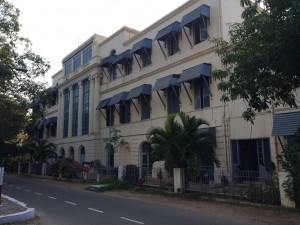Registered with the Registrar of Newspapers for India under R.N.I 53640/91
Vol. XXV No. 9, August 16-31, 2015
Archives: Vol. XXV No. 9, August 16-31, 2015
How anti-national is all this?
by The Editor
Madras Week enters its 13th edition this year. It looks as though it is all set to become yet another annual highlight of Chennai’s social calendar, like the Music Festival and The Hindu’s Lit for Life event. There is a sense of anticipation among people even as the event approaches and this is also reflected in the increasing levels of participation.
And yet there is a certain section that persists in dubbing Madras Week as elitist and being an apologist for the British Raj. One Tamil newspaper has even gone to the extent of claiming that by celebrating Madras Week, the organisers are indulging in anti-national activities! While it is gratifying to think that someone is writing about us for a change (and that means we are getting noticed), the grave nature of the charges forces us to reiterate what Madras Week stands for and what it hopes to achieve.
The article referred to stated that it saw no reason why Madras Week had to be celebrated given that several areas of the city are far older than the 376 years of Madras’ existence. We have never denied the antiquity of some of the villages that eventually came to form Madras city. In fact, when the Government began setting about changing the official name of the city to Chennai, we had suggested that Mylapore would be a far better option given that it was one of the oldest parts of the city, far older than Madras or Chennai. And don’t we already have a Mylapore festival that is older than Madras Week itself and is it not organised by one of the prime movers behind Madras Week? And have we not been repeatedly highlighting the necessity to have local area festivals on the same lines?
Is Madras Week really an occasion that just celebrates the colonial past? Nothing can be further than the truth behind this charge.
It’s back to renaming streets
BY THE EDITOR
Our Corporation is at it again. Having in its opinion solved all problems such as potholes, illegal constructions, and garbage clearance, it found time hanging heavy on its hands and decided to work on changing the names of several roads of the city. It is high time that the powers that be realised that such exercises are futile ones and the watching public is largely indifferent to such gimmickry. In fact, what the people want is delivery on several civic issues and nothing other than that is going to be acceptable.
Know your Fort better
Sriram V.

Admiralty/Clive House.
Parade Square, as we saw in the previous issue, stands more or less in the middle of the Fort. Radiating from it are streets in all directions. It must not be forgotten that the Fort was once very much a town with its residents. And these needed houses, all of which were placed along the various streets that crisscrossed the entire precinct of White Town, as the Fort was known. Interestingly, as H.D. Love points out, the residents of Madras referred to the Fort as the City and to what lay outside of it as Town. The East India Company reversed the nomenclature – according to it, Madras was the city and the Fort was the town!
The changing world of Tambrams
T.C.A. Srinivasa Raghavan
Tamil Brahmans: The making of a middle-class caste by C.J. Fuller and Haripriya Narasimhan. Social Science Press/Orient BlackSwan. Price: Rs. 750.
As is evident from my name, or should be, I am a Tamil Brahman. But I have lived 97 per cent of my life in Delhi where I have gone to school with post-partition Punjabi children and, later on, mingled with Jats and other assorted North Indians throughout my working life.
The City’s second widows’ home
K.R.A. Narasiah
The first shelter for destitute women in Madras was a home for Brahmin widows started by Sister Subbalakshmi. There was also in the city a hostel for non-Brahmin women and an orphanage for girls run by Christian missionaries.
On an evening in June 1930, three young girls from Namakkal turned up in Dr. Muthulakshmi Reddy’s house seeking shelter as they had nowhere to go and their relatives would not help them either.

